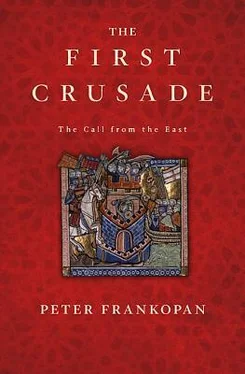Other leading figures also disappeared from view, a telling clue to their involvement in the plot. One was Nikephoros Melissenos: once Alexios’ rival for power, Melissenos had turned into a sour figure, sniping at the emperor and openly stirring dissent. 53Now he too was quietly removed. 54The same was true for Nikephoros Komnenos, about whom very little is known, apart from the fact that he had been in charge of the imperial navy at some point before 1094. 55He no longer held this post by the time of the Crusade, when it was occupied by Eustathios Kymineianos. 56It was not just the Byzantine elite that had turned on Alexios therefore; his own family were deserting him.
Alexios’ regime was under serious threat. The emperor moved quickly to conceal the true extent of the plot. A report was circulated that the conspiracy had been revealed to the emperor by Constantine Doukas. This simply was not true. 57In a telling admission of just how far the emperor’s stock had fallen, Alexios was forced to rely on lies to claim that he still enjoyed the confidence of leading figures in Byzantium. Public knowledge of the damaging involvement of the ex-empress Maria was also suppressed. 58The Alexiad indicates that many leading figures as well as the rank and file of the army were implicated in the conspiracy. 59The emperor’s supporters, meanwhile, ‘were now limited to a handful of men and his life was in danger’. 60
The emperor called a crisis meeting of his loyal relatives by blood and marriage – ‘those, that is, who were really devoted to him’, according to Anna Komnene. Trying to take control of the situation, Alexios took a courageous decision: he announced that he wanted to hold a general assembly the next day so that he could address all those who were on campaign with him in person. As dawn broke the following morning, a procession accompanied Alexios to the imperial tent, where he took up position in front of the gathered troops. Resplendent on his golden throne, his cheeks burning red with anticipation, he faced the crowd. The tension was all but overwhelming. 61
Men loyal to Alexios took position next to the throne, armed with spears and swords, while members of the Varangian guard formed a semicircle behind the emperor with their heavy iron axes slung over their shoulders. Alexios was dressed not in imperial robes, but in the modest clothing of a soldier, a statement rich with symbolism and intent. If he was about to be hacked to death, it was as a soldier that he would fall. The emperor’s reign and the fate of the Byzantine Empire seemed to turn on this moment.
‘You know that Diogenes has never suffered ill at my hands’, Alexios began. ‘It was not I who deprived his father of this empire, but someone else entirely. Nor have I been the cause of evil or pain of any sort as far as he is concerned.’ Although he had always looked after Nikephoros, he had been consistently ungracious and above all selfish, said the emperor. Diogenes had repaid Alexios’ kindness with treachery. He had been repeatedly forgiven for undermining the emperor and even being caught plotting to take power, he continued. ‘Yet none of my favours has succeeded in altering his perfidy. Indeed, by way of gratitude, he sentenced me to death.’ 62
To the emperor’s relief, his speech had an immediate impact on his audience, as men started to exclaim that they did not wish anyone to take Alexios’ place. This reaction was not simply the result of wellchosen words, but also stemmed from a rising sense of panic as the crowd feared that the emperor’s guard was about to embark on a mass slaughter of the assembled gathering. When Alexios then talked of forgiveness and offered an amnesty to all who were present on the basis that the main conspirators had been identified and would be punished separately, pandemonium broke out: ‘A great clamour arose, such as none of those present had ever heard before and have never heard since, at least to judge from those who were there; some praised the emperor and marvelled at his kindness and forbearance, while others abused [the leaders of the conspiracy], insisting they should be punished by death.’ 63
The chief conspirators were spared the death sentence in spite of the seriousness of their crime but were disgraced and exiled; Nikephoros Diogenes and his fellow ringleader, Katakalon Kekaumenos, were blinded. 64But Alexios was genuinely shocked that such strong opposition had been fomenting against him, and according to Anna Komnene, the conspiracy had a major impact on his mental and physical health. 65Anna reports that anxiety would plague him later in his reign, causing him on some occasions to find it difficult to breathe. 66
The setbacks in Asia Minor of the early 1090s had been at the heart of the efforts to depose Alexios, but it was the emperor’s decision to take a major military force to review the north-western frontier and tackle Serbian raids that sparked fury with the disillusioned elite in Byzantium who felt their interests in the empire’s heartlands were being deliberately ignored. Central to Alexios’ success after taking the throne in 1081 had been his consolidation of power and his creation of a political system with himself at the heart of every appointment, every military expedition and every policy. This in turn was based on weakening the authority and influence of the aristocracy, which was achieved indirectly through the centrality of the emperor’s own role, and directly through the reduction and removal of salaries. Heavy taxation, officious revenue gathering and politically motivated confiscations also served to reduce the fortunes of the ruling classes in Byzantium.
Such treatment of the empire’s nobles had brought his reign to the brink of disaster. When he returned to Constantinople after the Diogenes conspiracy was uncovered in 1094, the emperor’s first action was to purge the ruling class. Those who had held important responsibilities in the first part of his reign were replaced by a new generation, promoted en bloc. The new officials were chosen not on the basis of their family wealth, connections or political importance, but on a more direct criterion: complete loyalty to Alexios. Amongst the principal beneficiaries were men from the western provinces; in a major recalibration of the empire itself, this marked a decisive swing in the distribution of power from the old dynasties of the Byzantine aristocracy of Anatolia to a new set of up-and-coming families from Thrace.
Others too sprang to prominence. Manuel Boutoumites appeared on record for the first time in the aftermath of the Diogenes revolt, rising from obscurity to hold some of the most sensitive responsibilities in Byzantium; he would play a major role during the First Crusade. Eumathios Philokales, a man so tough that one holy man felt he would not even be saved by prayer, was plucked from the backwaters of the Peloponnese and appointed governor of Cyprus once Alexios’ authority on the island had finally been restored. 67Others, like Niketas Karykes and Eustatios Kymineianos also found themselves promoted to leading positions in the wake of the attempted coup. 68Then there was Nikephoros Bryennios, hand-picked by the emperor to replace Constantine Doukas as fiancé to Anna Komnene. 69
The sweeping changes of 1094 saw foreigners rise even higher than they had before. Peter Aliphas, the Norman who took service a decade earlier, became increasingly relied upon by the emperor. 70The imperial navy was placed under the command of Landulph, whose name suggests he was of Lombard origin, and the first non-Byzantine to take charge of the imperial fleet. 71The ever-reliable Tatikios, meanwhile, was pushed to the very top of the army; he too would be given one of the most sensitive and important tasks during the First Crusade. 72
Very few leading officials survived the reshuffle. George Palaiologos and John Doukas still had roles to play, the former zealously promoting the emperor’s best interests during his negotiations with the Crusaders, and the other spearheading the recovery of western Asia Minor, 73together with Constantine Dalassenos. 74But the clearing out of the old guard carried risks. There were real dangers in removing in one fell swoop all those who had lent their backing to Diogenes or who had shown other signs of discontent. As a result, it seems that at least in some cases, removals were phased. Nikephoros Melissenos, for example, was still active some months after the conspiracy, serving on campaign against Cuman steppe nomads in the spring of 1095 where he was closely watched by newly promoted senior commanders before quietly slipping from view. 75
Читать дальше











